
BILSTON AFTER THE NORMAN CONQUEST
This page is decorated with line drawings taken
from medieval manuscripts. They have no specific connection
with Bilston but do represent typical scenes from the times.
The chief, if not the only,
effect that the Norman conquest had on Bilston was that one set of
landowners was replaced by another. For the inhabitants the round
of agriculture would have gone on as before.
Lawley gives the following
translations of the local entries in Domesday Book:
In Bilston there are two
hides of land, which is four caracates, and there are eight
villeins and three boarderers with three ploughs. Also one acre
of meadowland. The wood is about a furlong long and a half
broad. Was worth 20s, now 30s.
Walbertus holds of
Williams (Fitz Ansculf) one hide in Bradley. There are 2
caracates, with them are 4 villiens having one plough. The wood
is 3 furlongs long and one furlong broad. Valued and now of the
value of 67 pence. Untan holds by sac and soc. There are two
acres of meadowland.
|
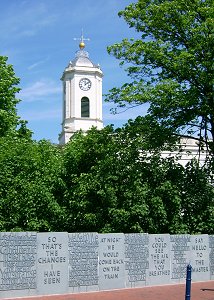
St. Leonard's in modern times. |
The figures indicate that
Bilston was, by the standards of its time, a sizeable village and
that Bradley might be described as less developed, having more
woodland and fewer inhabitants.
There is no mention in Domesday
Book of a church in either Bilston or Bradley and this
is certainly because the church at Wolverhampton was the
local parish church.
Lawley insists that
there was a church of some sort in Bilston from the earliest
Christian times and that references in old deeds to Wolverhampton
church and its chapelries show that there must have been a chapel,
at least, in Bilston. It is possible; but it is more likely that
St. Leonard’s found its origins at the end of the 11th
century, when there was a spate of church building throughout the
country. |
It seems that after 1066
Wolverhampton and its surrounds came to be in only two manors, the
Deanery Manor and the Stow Heath Manor. Stow Heath spread from the
centre of Wolverhampton to the east and Bilston itself was in it.
Bradley was not – it was in its own Manor of Bradley. Of Stow Heath
manor Chris Upton (in his “A History of Wolverhampton”, (1998)) says
that “Stowheath represented, in fact, a merger of the royal manors
of Bilston, Willenhall and one half of Wolverhampton, a process only
completed in the 13th century. The first lord of the
manor was Robert Burnell, Bishop of Bath and Wells and Chancellor of
England until his death in 1292. His main dwelling was … at Acton
Burnell”.
| The descent of the ownership
of the manors of Stow Heath and Bradley can, to a large extent, be
traced – and the details are in Lawley. Suffice it to say here that
Stow Heath Manor came into the hands of Bilston based people and
seems to have been run from the house which is now the Greyhound and
Punchbowl. Where the manor of Bradley was run from is not known.
The main function of a manor was to regulate the course of
agriculture in its area, though it exercised rather wider influence
over its inhabitants than that might suggest, not least because, in
early post-conquest times, there was not the same distinction
between criminal and civil matters as we would make today.
|

The Greyhound and
Punchbowl in modern times. |
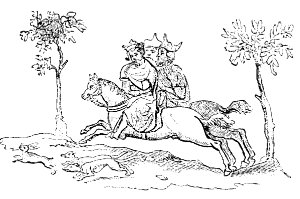
A royal hunt in a royal forest
such as Cannock Chase or Kinver Forest. Bradley
seems to have been a hunting ground, but not a royal
one. |
In addition to the manorial
courts, the area would have been run by various royal officers in
various guises, most of whom would, in due course, have been
replaced by magistrates (or Justices of the Peace) sitting in petty
sessions and quarter sessions, at both of which minor criminal
matters would have been dealt with, alongside some civil matters.
There would also have been a hundred court – and Bilston was in Offlow Hundred – and a county court. These courts would have dealt
mainly with what we would see as civil matters. Doubtless
Bilstonians attended all these courts but their impact, other than
that of the manorial courts, on their daily lives would have been
small. |
| In medieval times we must
imagine Bilston as a village, surrounded by open fields and some
meadowland, and, beyond them, woodland areas on all sides, with the
extensive royal forests beyond them to the north and to the west.
The village’s principal roads would have been much as they are now
with the exception of Wellington Road and Oxford Street, both of
which were not to appear until the 19th century.
|
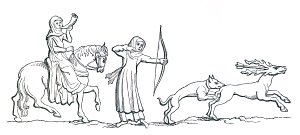
Ladies hunting. In medieval times women could be strong and independant
figures. |
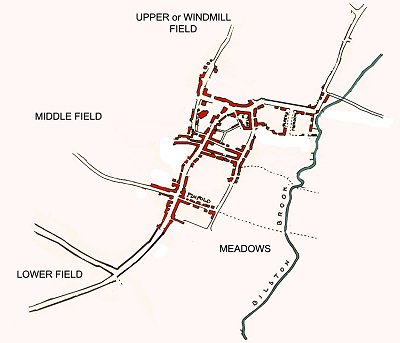 |
A rough guess at how Bilston
would have been in the later medieval period, with three
open fields around a village centred on the church; and
meadow lands between the village and the brook. (Based
on an adaptation of the 1832 map of Bilston).
|
Water would have come from wells and, at
a little distance, from the brook. The chief well was known as
Crudely or Cruddley Well and was situated, Lawley says, “just off
Lichfield Street, near to the entrance to Proud’s Lane”. There was
another well at Spring Vale, known as Lady Wulfruna’s Well. Both of
these wells were considered, from time to time, to be Holy Wells
with curative properties.
| The village would have been
not unlike that shown on the 1832 map of the town –
basically a village spread along a single street
with a few branches off it developing over a period
of time. The housing would have consisted of
an accumulation of cottages – mere hovels to our
eyes – and a wider scattering of the better houses
of the better off landowners. These houses
would have been “half timbered” on brick, or
possibly stone, bases. |
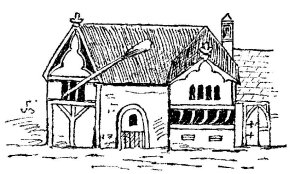
A medieval
house of a good class. |
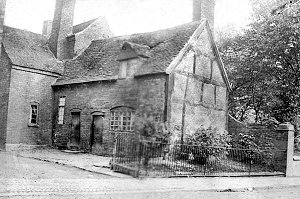
Medieval timber framing, still
around at the start of the 20th century. Thanks to
Eric Woolley for this. |
The single street layout
would have been broken around the chapel, as it is today. A chapel
is known to have existed on the site of St. Leonard’s, in 1090, when
the priest was one Robert Fitzstephen.
Lawley describes this as a
free chapel, one not allocated to any of the prebends of St.
Peter’s. But a chapel it was and a chapel of ease
– that is an ecclesiastical building, with a curate (not
a vicar or rector), which was provided for the
convenience of people living at some distance from their
parish church, in this case, St. Peter’s.
|
In theory the curate would
be appointed by the mother church; but the practice later developed
of the curate being elected by the townspeople. A chapel of ease
could not perform christenings, churching of women, marriages or
burials. How it came about that, eventually, all of this
ceased to apply to St. Leonard’s, even before it became an
independent church, can be read elsewhere.
| Beyond the village, presumably
near the brook, was some meadowland, which would have
been used for making hay and grazing cattle.
The
back yards of the cottages would have been used for
growing vegetables and keeping pigs and the pigs would
have foraged the surrounding woodlands. |
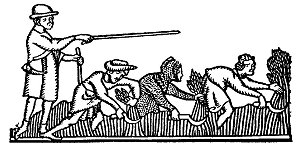
Reaping the
lord's land under his steward. |
|
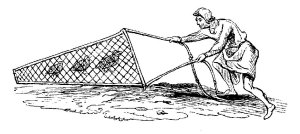
Netting birds. |
The
main agricultural activity of crop farming would have been carried
out in Bilston, as it was almost everywhere else in the Midlands, in
open fields. These were very large fields which were divided into
strips (usually about a furlong long and about 20 feet wide) and the
villagers would each have held an allocation of strips scattered
around each of the open fields. |
| Bilston had a market, almost
certainly on the site where it still is; although the date of its
origin is uncertain, Lawley says that a market charter was granted
by Edward III. At some date a “market cross” was
erected. A market cross was, originally, just
that: a large cross, on a plinth, which marked the
centre of the market and around which local people came
to sell their goods to other locals and visitors.
Later the cross itself might have been replaced by a
building, usually in the form of an open area at ground
level, with an upper floor supported on pillars. |
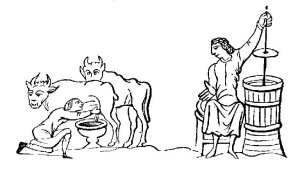
Milking cows and
churning butter. |
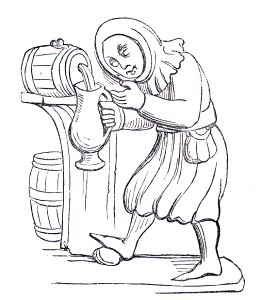
A tapster. It is reasonable
to assume that Bilston would have acquired some beer
houses and an inn or two. |
Bilston seems to have had two crosses: the Nether Cross
and the Overas Cross. The Overas Cross was taken down in 1698 and
the materials used to rebuild the Nether Cross. As was common with
such buildings the open area beneath the Overas Cross was bricked in
to form a ground floor room. In 1738 it was leased to a private
individual and thereafter disappears from the records.
Open field systems of
agriculture usually had three open fields, but variations on this,
from two to five fields, are not unknown. We do not know for
certain how many open fields Bilston had but it seems, from the
names occurring at various points in Lawley’s History, that there
were three: Upper or Windmill Field; Middle
Field; and Cole Pit Field. |
| One would guess that Middle Field was to the west of the
village (where Middle Field Lane ran); that Upper Field was to the
north and west, it being described in 1458 as lying “near the way
from the said Bilston to Wolverhampton”; and that Lower Field was to
the south, the eastern side being occupied by the meadow near the
brook. It was the chief business of the manorial court to decide on
the course of agriculture – what was grown in each field; when
ploughing, sowing and reaping took place and when, after harvest,
the fields were to be thrown open to all villagers for grazing. The
notes made by the Reverend Ames show that this system of agriculture
was still operating, over a greater or less area, in his time.
The name “Windmill Field”
indicates that there was a windmill but windmills did not appear in
England before the 13th century; before that corn
was probably ground at a mill powered by the brook.
Certainly there was a water mill, as one is mentioned in
a deed of 1378 cited by John Price. |
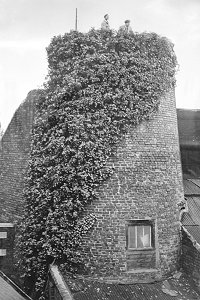
Bilston windmill
- a post-medieval construction. Thanks to Reg
Aston for this. |
How land in Bradley was laid
out and used is even more obscure. Lawley suggests that the area
was used mainly as part of the Earls of Dudley’s hunting grounds;
and he finds only five capital messuages there (that is, five houses
of any size). There is a reference, in 1378, to Boverbrook Field
and a reference to Broad Meadow in 1459 and this may show that there
were open fields and a meadow in that manor as in Bilston. The
names of some landowners are known and appear in Lawley, as do the
names of many more in Bilston itself.
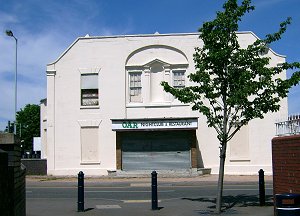
Pipe Hall, named after a local
landowning family; but this was built long after the
Pipes had left the area. |
These landowners were all people
who, by hard work, wheeling and dealing, or just good
fortune, accumulated much of the land into their own
hands and built the larger houses in the village.
They were also, as like as not, the leaders in
“enclosing” the open fields.
Enclosure was the
process by which the old strip farming was abandoned,
scattered strips were brought together and enclosed in
fields of the shape and size with which we are now
familiar. This was often done in one fell swoop under
the compulsion of an Act of Parliament; but there
is no Act covering Bilston or Bradley. |
| So there must have been what
is known as “enclosure by agreement” whereby, possibly over a
prolonged period, maybe decades or even longer, swaps and purchases
of strips were agreed between their respective owners until everyone
had his land in consolidated areas like modern fields.
The written
record reflects this process. In Bradley a deed (said to be of 1479
but strangely worded for that date) mentions an area of land “taken
and enclosed before Queen Mary’s time” and that before it was
enclosed it was called Broad Meadow. This is not entirely clear but
the early date (if accurate) suggests that this enclosure was
carried out by a landowner for the purposes of producing a sheep
run. If this is the case the deed also reflects the undoubted
importance of sheep farming to the area. |
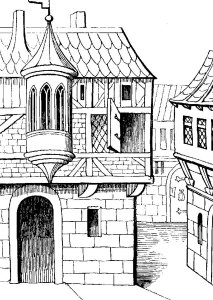
A medieval town. |
|
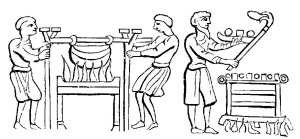
Cooking for a feast. |
Land in a manor’s open fields was
(certainly for the greatest part) not freehold but
copyhold. Copyhold tenure depended on registering
one’s title, and all dealings in the land, with the
manorial court. As land was enclosed the manorial
court no longer needed to meet to regulate the course of
agriculture and, very often, manorial courts fell into
decay. This meant that land transactions in
copyhold land became difficult and uncertain.
|
| It may be that this happened in
the whole of the Black Country area, with prime land
within and immediately around the villages becoming
enfranchised as freehold land, and the rest remaining
copyhold. It is possible that much mining and
other industrial development could take place between
the villages because it became uncertain who owned the
land or had any form of control over it. |
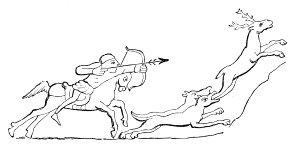
A stag hunt.
This sport would have been the preserve of the nobility. |
|
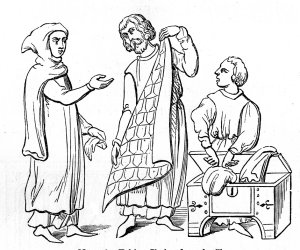
A cloth merchant. |
Dr. Rowlands finds, in most of the Black Country, a
relatively strong manorial system in which the custom of some manors
gave underlying minerals to the copyholder and some to the lord of
the manor. Which category the Bilston manors fell into is not
clear.
But, one way or another, through the manorial courts or
through encroachment, there seems to have been no legal problem in
exploiting the mineral wealth beneath Bilston. This aspect of the
development of industry in the area merits further investigation. |
Most of the Bilston
landowning families remained in the area or thereabouts. Only a few
appear on the national scene. For example, the Pipe family provided
a merchant who became Lord Mayor of London; and the Hoo family, from
Bradley, provided a Sergeant-at-Law – a lawyer somewhat above the
modern Queen’s Counsel and not much below the judges. Dr. Rowlands
refers to them as “lesser gentry”.
|










